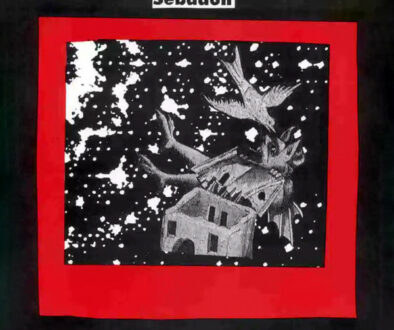With His Blue Cock on Proud Display (Book Three, Part 8: Grant Morrison)
Previously in The Last War in Albion: Grant Morrison conceived of Animal Man as a postmodernist comic, a school of thought that was in many ways comparable to their beloved school of Chaos Magic.
The God of Watchmen was far from shy. He liked to muscle his way into every panel, every line. He strutted into view with his blue cock on proud display, and everywhere you looked the Watchmaker was on hand to present his glittering structure for our approval and awe. —Grant Morrison, Supergods

As Morrison explained it, “Chaos Magic as I understand it is simply a description for a type of modern quasi-shamanic practice which incorporates ALL other magics, allowing the practitioner to choose from a constantly changing postmodern menu of techniques, gods, cosmologies, rituals etc. Chaos Magic might use a traditional Enochian ritual as the framework for an invocation of Clive Barker’s Pinhead or Mickey Mouse. Chaos emphasizes work and results over abstract theorizing. In addition to sorcery, it makes use of Reichian body therapy, NLP and Ericksonian hypnosis to facilitate the creation of multiple creative selves.”
More directly related to Animal Man, however, is the Argentinian writer Jorge Luis Borges, mentioned by Morrison in several interviews as an influence on their work. Like chaos magic, this is an influence that can be found on multiple Morrison works, including explicitly in their Doom Patrol run. But two stories apply particularly to Animal Man. The first is “Pierre Menard, Autor of the Quixote,” which Borges writes in the form of a mock essay analyzing the work of Pierre Menard, a man who threw himself into Don Quixote and the life of Miguel de Cervantes with such vigor that he was able to recreate Don Quixote from first principles, composing a version of it which is in practice word for word identical to the original. Borges’s story, with straight-faced humor, then proceeds to elucidate the ways in which these identical works are in fact profoundly different, discussing how “It is a revelation to compare the Don Quixote of Pierre Menard with that of Miguel de Cervantes. Cervantes, for example, wrote the following (Part I, Chapter IX):
…truth, whose mother is history, rival of time, depository of deeds, witness of the past, exemplar and adviser to the present, and the future’s counselor.
This catalog of attributes, written in the seventeenth century, and written by the “ingenious layman” Miguel de Cervantes, is mere rhetorical praise of history. Menard, on the other hand, writes:
…truth, whose mother is history, rival of time, depository of deeds, witness of the past, exemplar and adviser to the present, and the future’s counselor.
History, the mother of truth!–the idea is staggering.” There is a clear line from this sort of game and the metafictional play of Morrison’s interpolation of Crisis, cheekily remixing “I Was the Man With Animal Powers” into his narrative as an actual comic, at once a living origin and a cast off piece of pre-Crisis continuity.”

An even more apropos story, however, is Borges’s one page “Borges and I,” a mournful account of Borges’s sense of alienation from his public persona. “The other one, the one called Borges, is the one things happen to. I walk through the streets of Buenos Aires and stop for a moment, perhaps mechanically now, to look at the arch of an entrance hall and the grillwork on the gate; I know of Borges from the mail and see his name on a list of professors or in a biographical dictionary. I like hourglasses, maps, eighteenth-century typography, the taste of coffee and the prose of Stevenson; he shares these preferences, but in a vain way that turns them into the attributes of an actor,” he writes, at once tragically and humorously, talking about his doomed efforts to push back against this other Borges, to claim a life separate from the part of him that he knows will outlive him. “I do not know which of us has written this page,” he concludes, staring his status not as an authentic self but as a literary creation of the famous man in its chilling face.

Morrison’s final issue of Animal Man is much the same. For it, Morrison created what they called a fiction suit—“a paper version of myself that could be integrated with the 2-D DC universe. I sent my avatar onto the page surface to meet the Animal Man character and confirm suspicions he’d been having that his life story was being written by some demiurgic Gnostic overlord.” And so at the end of Animal Man #25 Animal Man walked up to a door to be greeted by the man who had been walking along a canal back in issue #14. “I’m Grant,” he greeted Dave Wood and Carmine Infantino’s creation. “You coming in?”

This was not, of course, Grant Morrison, the newly thirty-year-old comics writer from Glasgow who was finishing up their Animal Man run in the course of a busy month that also included issues of Doom Patrol, their Gothic arc on Legends of the Dark Knight, and their story for the final issue of Secret Origins. They didn’t live in a house accessible via comic book limbo, weren’t colored by Tatjana Wood to have an unsettling alabaster complexion, and indeed were not actually creatures of pencil and ink in the first place. This was Grant Morrison, a newly thirty-year old comics writer from Glasgow who was finishing up his Animal Man run in the course of a busy month that also included issues of Doom Patrol, his Gothic arc on Legends of the Dark Knight, and his story for the final issue of Secret Origins. He lived in a house accessible via comic book limbo, was colored by Tatjana Wood to have an unsettling alabaster complexion, and indeed was simply a creature of pen and ink within a comic book universe. At one point Morrison explains to Animal Man that “you existed long before I wrote about you and, if you’re lucky, you’ll still be young when I’m old and dead.” And while Grant Morrison is in point of fact a creation of Grant Morrison and Chas Truog with no prior appearances in DC Comics (although he bears a marked resemblance to the narrator of the one page strip “Born Again Punk” in issue four of UK indie anthology Heartbreak Hotel), he too would remain young even as Morrison aged into a distinguished veteran of the industry. Perhaps most poignantly, he would always be male even as his creator eventually came to discover that their understanding of their own gender was better described as nonbinary, a thirty-year-old’s misunderstanding of themself trapped forever on a comics page in the forlorn hope that some day someone will update him for the new continuity and give him a new gender identity in the process.

Grant Morrison is somewhat juvenile writer; he forces Animal Man to murder him in order to demonstrate his power over him, explaining, “I thought we needed some action at the start of the story, just to keep people interested.” Later, he conjures a group of generic superheroes from the canal just to blow them up in a firework of blood. “They’re not part of the story,” he shrugs. “I only put them in to make this conversation more interesting to draw.” Later he proclaims the issue boring and demands a fight scene, having Animal Man attacked and brutally beaten down whilst he offers thanks to his various collaborators and encourages readers to join PETA. These are clearly jokes on Morrison’s part, designed to create a distance between themself and their avatar; the line about making the conversation more interesting to draw, for instance, is followed by a number of panels in which Truog draws a bevy of surreal and contextless images. Perhaps most obviously, Morrison has Morrison justify the deaths (murder?) of Animal Man’s family, saying, “it added drama. All stories need drama and it’s easy to get a cheap emotional shock by killing popular characters.” But this and Morrison’s later insistence that he can’t bring them back because “it wouldn’t be realistic. Pointless violence and death is ’realistic’. Comic books are ‘realistic’ now” are not what they actually think; they hate that trend, and Animal Man was an active reaction against it. Indeed, all of these protestations on Morrison’s part exist only to be undermined when he changes his mind to match his creator’s actual views, saying, “We thought that by making your world more violent, we could make it more ‘realistic,’ more ‘adult.’ God help us if that’s what it means. Maybe for onc we could try to be kind,” and finally relenting and restoring Buddy’s family to life. In the end, like Animal Man, Morrison is little more than a mouthpiece for his author’s passions, his dramatic arcs existing only to serve his master’s needs.
There is no point in being coy about what these needs were. Whatever dramatic satisfaction Animal Man #26 offered—and it was in point of fact considerable—it was also unmistakably part of Grant Morrison’s efforts at becoming a celebrity. As Steve Yeowell notes, “What you have to remember about Grant is that [their] greatest creation in a lot of ways is [them]self.” And Grant Morrison exists because of this. He was his creator’s signature, there to help them create yet another Grant Morrison—Grant Morrison the celebrity comics writer and infamously creative, clever fellow. By striding in to provide the comic’s resolution, Morrison ensured that even casual readers who were only brought in by Brian Bolland’s flashy covers and didn’t pay attention to creators knew who it was that had made Animal Man. He was an extension of the “exaggerated caricature partly inspired by the Morrissey interviews I enjoyed reading” that Morrison was adopting to write their Drivel columns in Speakeasy, right down to his cheeky exchange with Animal Man about how someone else writes Justice League Europe, prompting animal Man to note, “Well, I suppose… I never seem to do much when I’m with the Justice League.”The point was to position Morrison as the comic’s auteur and star attraction—not Truog or Bolland or the obscure DC character, but them, the brilliant writer brave enough to play with the implications of Crisis on Infinite Earths.

But all of this would only work if the comic was good, and Animal Man #26 very much was. The postmodern comedy of a character angrily confronting his author was balanced not only with thoughtful musings on violence and ethics, but with moving personal touches. Defending himself against Animal Man’s insistence that murdering his family was unfair, Morrison replies, “No, it’s not. One of my cats died last year. Something, maybe a bone, punctured her lung. Pus built up in her lungs so that she couldn’t breathe. She suffered for four weeks and then died at the vet’s, a couple of weeks after her third birthday. Her name was Jarmara. That wasn’t fair either, but who do I complain to?” Later, he confesses that while Jarmara was ailing, he “took her to the vet every Tuesday and Thursday. I liquidized her food and fed her with a dropper. I prayed for her to get better… I’d have done anything to save her, really. And yet there was a part of me—the part that observes and writes—rubbing its hands and saying, ‘well, at least if she dies, I’ll be able to use it in Animal Man. It’ll add a nice touch of poignancy.’” And at the issue’s end, after Buddy has been reunited with his family, they return to their fiction suited avatar, sitting at his computer, finishing up the script. He looks at a picture of Jamara, and begins to tell a story, returning to the narrative about Foxy, his imaginary friend discussed in issue #10 and given a role as James and Buddy’s spirit guide for the peyote trip in issues #18 and 19. Morrison explains again how he used to stand on a hill and signal at Foxy with a torch. He returns, “toiling up a hill in the bitter wind,” and shines his flashlight out into the dark. “Are you there? Can you see me? Foxy, I came back. I didn’t forget. I came back.” But there is no response. “No light at all. Clouds pile up in the darkness. Curtains are drawn. Windows blink and go dark. Wind whines int he power lines. Stars go out. Streets are empty. Goodbye.” Grant Morrison walks away, and after a silent, empty panel of the Glasgow skyline there is a single flash in return.

Grant Morrison would make a further appearance just over a year later in John Ostrander and Kim Yale’s Suicide Squad. Recruited into the eponymous squad, he explains that “once I actually wrote myself into the story, technically I became part of the continuity and now someone else is controlling me as I used to control my characters! It’s horrible!” With a portable computer strapped to his chest, he endeavors to reshape reality, constrained only by the speed of his thoughts and fingers, and, occasionally, by Ostrander and Yale, who can get ahead of him and reveal what’s about to happen. Sent into combat as part of DC’s 1991 War of the Gods crossover, he has an unfortunately timed moment of writer’s block and is ripped apart by a werewolf-like creature.
As for Grant Morrison, they got what they wanted. Indeed, by the time Animal Man #26 came out in June of 1990 they had by and large already secured it, penning what would become the best-selling original superhero graphic novel ever released in the form of Arkham Asylum. [continued]





May 18, 2021 @ 4:00 am
The Borges connection vindicates my choice to write a college essay comparing Doom Patrol’s first arc to Tlon Uqbar Orbis Tertius.
I once saw someone adapt the end of Animal Man into a short play, it was very unexpected when I realised what it was.
May 19, 2021 @ 2:30 pm
These last few issues are such a hot mess. They shouldn’t be as good as they are. Half the stuff that happens makes no sense at all even in the context of the metafiction — why do five years pass? What was the monkey, why did it die? What’s the point of the graveyard of extinction?
(Actually, we know the answer to that last one: it’s because Truog did a few pages of art for the written-but-then-cancelled script for the “lost issue” that would have been #7 or #8. Those pages included the graveyard, so they got recycled. Perhaps they made more sense originally? Or maybe not.)
Trivia: Comic Book Limbo was created as a throwaway gag a few years earlier by Keith Giffen for Ambush Bug. But Morrison dramatically expanded it, and afaik nobody but Morrison has dared to use it since.
Trivia2: apparently this is the absolute last appearance of Binkie Biggs, DC’s attempt at an Archie knockoff.
You’re right that Morrison was flexing here. Other comics creators had done occasional cameo self-inserts — Stan Lee and Jack Kirby did it any number of times. But they were Stan Lee and Jack Kirby, and they certainly didn’t devote an entire issue to it.
(There is that one issue of Fantastic Four where the Four meet God — straight-up God — and He looks just like Jack Kirby. And it currently seems to be canon in the Marvel Universe that there is a God, and at least some people perceive him that way. But Kirby was long dead by the time this became a thing.)
Coming back to why this final double-arc is so good… from the mesa issue onwards, it has a propulsive dream / nightmare logic to it. One thing comes after another and it doesn’t make sense but it does.
Also, the kitchen sink madness of leaning hard into the superhero universe is already brain-fizzing even before Animal Man reaches the asylum: time travel! teleportation surfers! Mirror Master! Tea with the Phantom Stranger! Rip Hunter and the Time Masters! Binky freaking Biggs! And then when we do get there… whoo. You don’t have to know who any of these characters are to appreciate (and be horrified by) what’s happened to them.
One last thought: Morrison created their own micro-Crisis. The last six issues of his run on Animal Man.. never happened. They’re not part of any continuity, and never will be. Alternately, the whole thing can be retconned as a peyote dream — the last seven issues take place in Buddy’s head, up on that mesa. Bad trip, man.
Doug M.
May 19, 2021 @ 3:28 pm
One… no, two other thoughts, looping this back to the War. Yeah, I have a lot of thoughts about these 30 year old comic books. But if Watchmen was the first opening blast of the War, then Animal Man — and especially these final seven issues — represents the first counter-salvo. This is where the challenger first strides forth, armed and clad.
FIrst, Moore as SF New Wave / Moore as modernist. Yes! Someone once defined the New Wave as SF belatedly acknowledging modernism, 40 years after the fact. And Morrison as pomo works too.
(Has SF had its pomo moment yet? Unclear.)
Second, I said earlier that Morrison liked their creation, Mirror Master. Going a bit further: Morrison likes a lot of the characters they write. There’s often a… warmth, there. Not all the characters, by any means. But Morrison likes Buddy Baker (though they write him as a bit of a doofus) and they definitely likes Mirror Master. They like Robotman and Crazy Jane and Flex Mentallo. Even when putting them through literal Hell, you feel that Morrison feels sympathy for them.
That’s not really true with Moore. Moore’s attitude towards his creations feels cooler and more distant. It’s not that he’s any crueler to them than Morrison, or that they’re any less nuanced or complex. But one feels that much of the time, they’re complex little wind-up mechanisms of narrative.
Drilling down: the bit where Morrison says “Maybe for once we could try to be kind”? One can’t imagine Moore saying this in that context. (Well: one can’t easily imagine Moore in that context to begin with. An entire issue of, say, Swamp Thing with Moore talking about himself? No.)
The “try to be kind” line is about five things at once. It’s a criticism of fans, it’s a criticism of the state of the art in 1991, it’s part of Morrison’s flex. But it’s also, I think, sincere — and it’s sincere both generally and very specifically. As a general exhortation to niceness, it’s sentimental, bathetic, almost treacly. But in the specific context of the comic — meaning, let’s undo the last six issues and give Buddy back his family, dog and all — it packs real punch.
(And can we just pause here and note that Morrison retcons those six issues out of existence and makes us like it? Normally “it was all a dream” is greeted with eye-rolls. Morrison has us misting up and punching the air!)
This is not to say that Morrison liking their characters is “better”. Morrison’s warmth can sometimes become bathetic or silly, and Moore’s detachment lets him land some very powerful emotional beats. But it does give a noticeably different feel to the whole thing. And I do feel it connects to Morrison’s concept of a “fiction suit”. After all, if you can /like/ a fictional character, then doesn’t that open you to the idea of in some sense interacting with or even becoming a fictional character?
Finally, emotional connection to a fictional character — what does that lead you to? Well, lots of places. Sometimes it leads you to cosplay… and sometimes it leads you to fanfic.
But peace, enough. Carry on, please! Reading with great interest.
Doug M.
May 20, 2021 @ 12:50 pm
I was hoping the ending sequence of #26 would be covered and I’m pleased that it was. Because that’s one of the best written things in comics I’ve ever read, especially the gut punch of the last panel. To this day it still moves me, perhaps even more now, decades later, when the imaginary friends have turned into characters I use for role playing or writing (pretend for a moment I actually accomplish the latter.) Buddy got his happy ending; Morrison, in the end, didn’t get theirs. It’s always those moving, emotional scenes I remember about Morrison’s run on Animal Man; the metafictional gags faded away, but I can remember that last part of #26 with my eyes closed.
Those pages made Grant Morrison my favorite comic book writer until Jonathan Hickman came along, and I still have a great fondness for their work today.
January 28, 2025 @ 11:06 am
Borges? Nah.
More Simply the animal man finale is a perfect replica of a part of Alasdair Grey’s “Lanark”.
I’m sorry